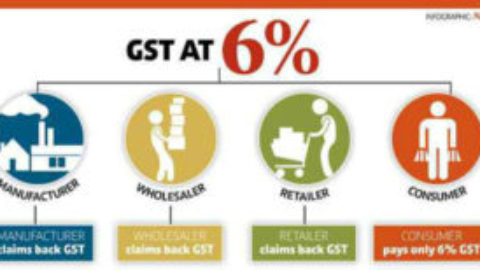
To know the top advantages of the proposed GST system in India we will have to first look at the GST system that is passed in India, as every country has their own set of rules and regulations.
GST will replace all the indirect taxes except for the customs, stamp duty, property taxes, which will reduce the cost of tax to minimum by eliminating tax on tax and many indirect taxes that are put on the line up of the tax chain. The state and the central tax rate becomes uniform making the things simpler for trade import and export. This will turn the country into one market and that is going to turn things into much easier.
The business that gets a turnover of more than 20 lakhs per annum has to apply for GST and there are other business that irrespective of this rule has to apply for GST and they are:
- Agents supplying on behalf of taxable person
- Interstate suppliers
- Casual and non-resident taxable person
- Business liable to pay taxes under reverse charge
- Input service distributor
- Agitator supplying services under his brand name
- Person responsible to deduct TDS
- Ecommerce sellers
- Online information database access
- Retrieval services from outside India to an unregistered person
Some of the advantages of GST system are
- Lower tax rates
In some of the states that are under VAT regime the businesses are required to comply with VAT regulations once they cross an annual turnover of Rs.5 lakhs. Under GST regime, GST liability accrues only if an entity crosses an annual turnover of Rs. 10 lakhs in northeastern states and 20 lakhs for rest of the country.
- Easier to do business
Many business like restaurants, computer sales and services businesses have to comply with both VAT and service tax regulations but with the implementation of GST it will decrease the burden from such business as they will have to pay only one tax and that is GST. Making the way of doing business much easier.
- Uniform platform
The implementation of GST in India the indirect taxes will be streamlined and standardized. Under the GST regime the business will no longer have separate VAT and service tax. GST will b the only tax that will be applied across the nation for selling, buying, providing services making a single market throughout the nation.
- Subsuming taxes
GST will subsume other taxes like central sales tax, additional customs duty, purchase tax, luxury tax, etc. Hence, under GST, many of the taxes in existence today would be subsumed and made into one tax. This would make tax collection and compliance easy for business across the country.
- Larger tax base
With the implementation of GST it is expected that the tax base will increase significantly. The overall tax liability for businesses will reduce overtime since more and more business will become compliant. GST will be joining hands with latest technology including data from Aadhar database, PAN database, etc, to make GST registration and GST return filing process as seamless as possible.
What are its impacts of GST system on different sectors?
Let us first look at it sector wise briefly before dissecting it.
- Service sector
The impact of GST systems will vary for every sector and classes of business. The service sector might suffer from it as they will have to register in every state where they provide service. The filing might increase by 2 or 37 considering there are three returns to be filed. In case the service distributor and the tax deducted at source registration are obtained in a state the number can shoot up to another 24 filings for each registration. And the service sectors that are only exposed to the central authorities would now have to be with state authorities as well that will increase their compliance cost.
- Manufacturer
The large manufacturers are already filing VAT, excise and CST hence the impact will be lesser on these businesses. The factory level excise and VAT registrations within a state can now consolidate into a single state – wide registration. The small or micro sectors that are enjoying only the excise will be heavily affected as the turnover has been brought down to above 20 lakhs for all the other states and for northeastern region it is brought down to 10 lakhs. In case of turnover upto 50 lacs, which provides for quarterly filing returns. These taxpayers are not eligible for input tax credit and wouldn’t be able to issue tax invoices. Apart from composition taxpayers, quarterly filing relaxation has not been extended to other businesses and hence majority businesses shall have comparatively more filings.
- Trading sector
The traders will have to register in every state from where they carry on operations. The compliance for traders will be doubled as they currently file only VAT CST return. For the first time traders will have to face the central authorities. Duplication of proceedings would surely add to costs. The small business traders who are planning to be a part of the credit mechanism will have to face heavy compliance costs.
- Input tax credit
This is the matter of concern as the online matching of input tax credits and reversal of credit or demand in case of mismatch. This process may turn out to be the most difficult part of compliance. Keeping track of mismatches, tallying the same with the books of accounts, accounting treatment of the same dealing with non-complaint vendors may require a team in itself. Problems similar to TDS return filing in income Tax may be expected during the first implementation days.
- General
Presently, no facility for filing for offline returns has been proposed. The small tax payers having inadequate infrastructure may find this GST system a little difficult and expensive. But the facilities like GST system providers and GST tac=x return preparers will mitigate this problem. The GST system is a complete online system and all the registration, compliance, returns will be done online. The accurate integration with the ERPs and accounting software will make the life easy for businesses. Proper planning can help in controlling the compliance activities from single location.
Automobiles:
It will result in 10-17 percent of fall in prices assuming 18 percent GST rate. Lesser benefits might be accrued by the tractors as these are against the taxes paid on input. Though looking on the bright side the automobile sector will emerge as the tax that this field is paying a much higher tax than the tax that will be acquired from it after the GST implementation.
It will lead to the easy and direct transfer of vehicles to the dealer. The stock will be transferred to your own warehouse and further will be transferred from warehouse to dealer.
Textiles
The tax for textile industry is divided into 9 categories at the moment that varies from 4 to 12 percent. The textile sector is also bound to pay taxes to the unorganized players who extract tax based on the size of the business. It depends on the fiber if it is natural or manmade as the synthetic requires high service and the natural requires almost no duty. The mills are taxed at higher rate more than the power looms which discourages the integration of production. The GST implementation will boost exports as it will have no complicated schemes.
Engineering, capital goods and power equipment
GST will have a positive impact on these and it will improve the prospects of engineering, capital goods and power equipment (ECPE) sector by reducing all the complications.
These industries are involved with both manufacturing and servicing of the goods which makes the tax rate of these business high because of double tax and also creates a puzzle ground of structure. This will be broken down into much simpler structure with help of GST due to common tax.
Hotels
Let us estimate that the GST rate will be 18% in this case the impact will remain neutral as currently the hotels pay 8.7 percent and luxury tax at around 8-12%. Restaurants pay service tax at around 5.6% and VAT at around 12%- 14.5%.
Logistics
GST will lead to elimination of central sales tax and inter-state value-added tax arbitrage possibilities. This will lead to consolidation of warehouses and increased efficiencies in the logistics chain.
Pharmaceuticals
It could bring a negative impact on this sector. The indirect paid by this sector could increase by 60 percent which is a thing to worry about and MRP could increase by 4 percent.
FMCG
The FMCG will receive a positive for household and personal care space. It will reduce 200 to 500 basis points, apart from reducing the warehousing and logistical requirements. However the working capital for retailers and additional tax rates for jewelry and cigarette manufacturers are negatives and will attract higher GST regime than companies like ITC which are going to be affected adversely.
Telecom
All the service related sectors are expected to suffer from this implementation as the service tax might shoot up. Even the moderate rise in tax could blow a hit on demand and profits. Having a GST system calls for you to have a business software that is cloud based i.e online software. Reach accountant is a GST ready software that helps your business in every possible way. It customizes and integrates easily. It is also easy to implement as it is simple yet a very powerful and intelligent software. It can be accessed from any device and is feature rich giving you all the facilities that your business demands as it has a next generation programing system.
For 15 days free trial of Reach accountant GST software click on>> demo









/0.png)
/1.png)
/2.png)
/3.png)
/4.png)
/5.png)
/6.png)
/7.png)
Now, the entire business platform have been processing through online platform direct tax online software reduce tax cost to lesser through reducing tax and several indirect taxes of the tax chain. It also includes interstate suppliers, input service distributor, business liable to premium taxes and some others.